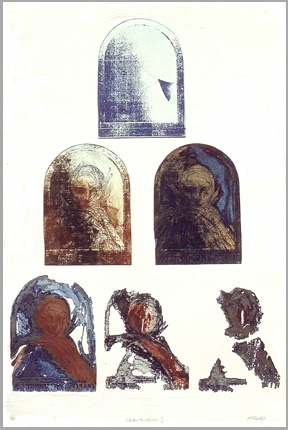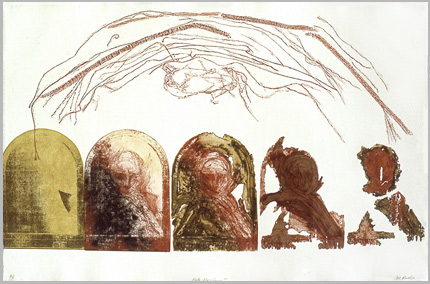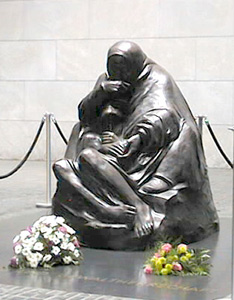Meta-morphosis II

Meta-morphosis II
Etching & Embossing
120cm x80cm
This edition was printed at the same time as Meta-morphosis I , using the same copperplate repeatedly etched and reprinted.

Meta-morphosis II
Etching & Embossing
120cm x80cm
This edition was printed at the same time as Meta-morphosis I , using the same copperplate repeatedly etched and reprinted.
June 1, 2004 in Meta-morphosis, Printworks Comments Off on Meta-morphosis II
Rock art of northern Europe is of great interest to me because of my roots, but unfortunately there are not many really good photo resources available online. So, when sorting through old bookmarks and coming across an article from a Finnish media site, YLE, about South African rock art, I became quite enthralled. This inspired me to dig further and find a wealth of beautiful material to study.
First, back to the article, which states that South African rock art is said to be one of the most complicated rock arts in the world. The research into this sophisticated ancient art form is considered very important in the post-apartheid era. […] South Africa is the cradle of humankind, the place where our very first ancestors lived. The oldest human skulls found in the area are more than two million years old. The oldest piece of art ever found on earth, a piece of ochre that was only found last year, is 77 thousand years old, says Dr. Benjamin Smith, the director of the Rock Art Research Institute, University of the Witwatersrand in Johannesburg, South Africa.
What is amazing when you view these images is how very sophisticated these works are. We have learned that rock art tells a wholly different story than the old history books written by white colonialists who wiped out the ancient local histories in South Africa ( and many other countries). Dr. Smith’s view is that archeology has a key role to play in making history relevant in South Africa.
The rural areas are the poorest in South Africa. Sustainable rock art tourism could help the people living there. The South African government has given large sums of money to build the guided tour centers. The work is done by local people, using traditional building techniques. Showing people that rock art is not just culturally valuable, but can also provide living to those living in rural areas, is the best way to protect the ancient art of South Africa.
Here are a few more related links:
Metropolitan Museum of Art
more images
Bradshaw Foundation, a vast site with images and writings about Tanzania, Namibia, West Central Africa, Niger and many other countries in the world. I just found it today and will be busy poring over this resource!
May 31, 2004 in Rock Art & Archaeology Comments Off on South African Rock Art
Here’s a great link that I had bookmarked and forgotten about for a while: NASA’s Astronomy Picture of the Day. They are truly incredible images that I wish I could claim as my creations!
What reminded me again of APOD was an entry by Pinseri (in Finnish) talking about Stonehenge and Manhattan in the same breath, so to speak. What is the connection? See this Manhattan sunset.
Stonehenge is very well known though I have never seen it in person, so this 360 degree view comes close, maybe even better since the site is now fenced in.
May 30, 2004 in Neat stuff, Rock Art & Archaeology 5 Comments »
How is your doppelganger or fylgia today? What do nixies, corrigans, dziwozony, yuki onna, erynnes and ajatar have in common (hint: they are all female)? What is a basilisk? Curious? Check out the encyclopedia of monsters, mythological creatures and fabulous beasts.
How about ghosts? “The forms by which men and women are haunted are far more diverse and subtle than we knew”, says Ernest Rhys, author of The Haunters and the Haunted, Ghost Stories and Tales of the Supernatural.
Found at plep ( May 29th, 2004).
Edited April 14, 2009. First link updated.
May 30, 2004 in Folk Legends & Myths Comments Off on monsters and ghosts

Meta-morphosis I
Etching, Collagraph & Woodcut
80cm x 120cm
I started with one copperplate of a cracked mirror on the left. After printing it on several pieces of paper (to make the edition), I added an image of a face, etched it some more, printed again… and kept on etching and printing to end with the right image. The last printing was the woodcut and collagraph (collaged textures glued onto the wood and inked). The uninked wood textures gave an embossing that does not show in this photo.
The Meta-morphosis series is partly about this process of continually etching and breaking down the copperplate and the image.
An artists’ statement will be posted soon!
May 28, 2004 in Meta-morphosis, Printmaking, Printworks 2 Comments »
I have been planning for some time to put up images of my older series of works on this site but have been delayed getting them ready. When I originally scanned the slides several years ago, the technology was not as good as it is today, so the colours are really not very true to the originals. The delay is in getting access to a much more superior scanner at the studio to rescan them. In the meantime, I decided to start posting a few that I have tried to correct as best as I can for now, and will replace them later with better ones.
These works that I will be posting are part of a very large series of etchings called META-MORPHOSIS.
May 28, 2004 in Meta-morphosis, Printworks Comments Off on posting images
Yesterday I wrote about the Bayly Art Museum exhibition The Power of Woe, The Power of Life.
Another fascinating print exhibition at Bayly is Universes in Collision: 19th Century Japanese Prints, again showing a large number of images.
Curator Stephen Margulies’ background statement is worth reading – some quotes here:
With cynicism, commercial canniness, and sincere poetry, the great color woodblock artists of the eighteenth and nineteenth centuries both exploited and identified with women. They celebrated and advertised “the floating world,” the world of Kabuki theater and the pleasure district (especially in Edo, the capital, now Tokyo).
Role-reversal was the norm in “the floating world,” as courtesans became noble through self-sacrifice and weak males cringed before the necessity of love. On the stage, males took on women’s roles (though Kabuki was founded by a woman). Such men were seductive to both sexes. On stage and in expensive bordellos and in woodblock prints, there was a complexly tender and violent play of identity.
Related to this I discovered Mysterium has just posted about a web companion to a PBS program Japan: Memoirs of a Secret Empire. Features include interactive pages on musical intruments and, just in time for this post, Japanese woodblock printing. Check out the additional links, especially The Production of Japanese Woodblock Prints.
May 27, 2004 in Art Exhibitions, Printmaking Comments Off on Japanese prints
The Bayly Art Museum, at the University of Virginia, has published online a wonderful exhibition called “The Power of Woe, The Power of Life” – ” Images of Women in Prints from the Renaissance to the Present”.
It takes an interesting feminist viewpoint as presented in the introduction, but for me it is of particular interest because these are prints – etchings, engravings, woodcuts and lithographs. The selected works are mostly by male artists, most notable of course being Durer & Picasso. I also love the clarity and crispness of Hendrick Goltzius’ engraving of The Holy Family, don’t miss this. There are works by some women artists too, like my idol Kathe Kollwitz … plus Isabel Bishop (great technique!) and a few others.
TIPS ON NAVIGATION: the easiest way to see all the images is to begin at the page with the gallery map, click on the word “entrance” (under “Enter Exhibition”) then click on the first image to get the full view and text info. When ready to move to the next one, click on words “next image” near the top left of the page, and continue thus.
Seeing Kathe Kollwitz’s works here reminded me how excited I was to see an exhibition of Kollwitz’s work in Bremen, Germany some years ago. It is so much more powerful in real life, though somber and still very timely today. I also saw her very moving sculpture, an enlarged reproduction of Mother with dead son (Pietà) in the Neue Wache (a War Memorial) on Unter den Linden, Berlin, (photo below).

Related links:
Printmaking techniques: here and here
Kathe-Kollwitz-Museum
Women in Art
Thanks to scribblingwoman (link expired) for the Bayly link.
May 26, 2004 in Other artists, Printmaking Comments Off on women in prints
A few days ago when visiting Mysterium*, I found this treasure: the Diamond Sutra, a Chinese Buddhist scroll printed in 868 that is the world’s oldest, dated, printed book…. yes oldest! It is featured in the British Library’s website Turning the Pages.
This is a gorgeous site showcasing many precious old manuscripts like Leonardo’s Notebook, some medieval illuminated manuscripts like the beautiful Luttrell Psalter, and my favourite of these, Sforza Hours, a Renaissance masterpiece. All handmade, written and illustrated books or scrolls that are precious works of art… highly recommended viewing!
Admiring all these gorgeous old manuscripts sent me searching in my bookshelves for my own treasure, though only a reproduction, but a good one: The Tres Riches Heures of Jean, Duke of Berry, the 1969 edition, like this one. Here are some pictures from it, as well as some of the story behind it, and still more images at The Web Gallery of Art.
* sadly, Mysterium no longer exists…link is removed
May 25, 2004 in Books Comments Off on ancient pages
It is the Victoria Day long weekend for Canadians and out here on the Westcoast, if you are not “away”, you are working in the garden and around the home. Gardening is what I am doing a lot of in May, and this weekend is when it is safe to start putting out tomatoes and the more delicate annuals, plus some of my tropical plants that I overwinter indoors.
It is also a weekend that home improvement projects are tackled. Our project has been a year long one counting the preparation and a wood shed, but at last we are laying the paving stones on the side walk and back patio! Such is the life of an artist and a partner who use their own labour, and not always in the studio! The weather’s beautiful, so back to work now!
(Thanks to mirabilis for the link.)
May 24, 2004 in Canada and BC, Culture, Home 3 Comments »
© Marja-Leena Rathje 2004-2024